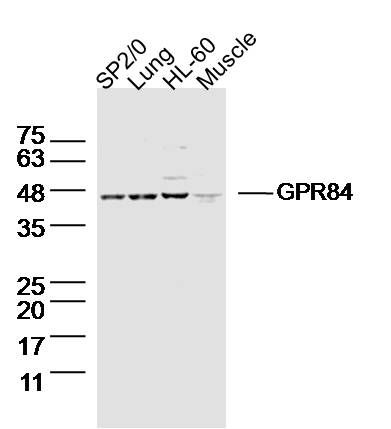产品货号 : mlR13507
英文名称 : GPR84
中文名称 : G蛋白偶联受体84抗体
别 名 : GPCR EX33; EX 33; EX33; G protein coupled receptor 84; G protein coupled receptor EX 33; G protein coupled receptor EX33; G-protein coupled receptor 84; GPCR 4; GPCR4; GPR 84; GPR84; GPR84_HUMAN; Inflammation related G protein coupled receptor EX 33; Inflammation related G protein coupled receptor EX33; Inflammation-related G-protein coupled receptor EX33; GPCR GPR84.
研究领域 : 细胞生物 神经生物学 信号转导 G蛋白偶联受体 G蛋白信号
抗体来源 : Rabbit
克隆类型 : Polyclonal
交叉反应 : Mouse, Rat, Dog, Cow, Horse, Sheep, Monkey,
产品应用 : WB=1:500-2000 ELISA=1:500-1000
not yet tested in other applications.
optimal dilutions/concentrations should be determined by the end user.
分 子 量 : 44kDa
细胞定位 : 细胞膜
性 状 : Lyophilized or Liquid
浓 度 : 1mg/ml
免 疫 原 : KLH conjugated synthetic peptide derived from human GPCR EX33/GPR84:1-100/396 <Extracellular>
亚 型 : IgG
纯化方法 : affinity purified by Protein A
储 存 液 : 0.01M TBS(pH7.4) with 1% BSA, 0.03% Proclin300 and 50% Glycerol.
保存条件 : Store at -20 °C for one year. Avoid repeated freeze/thaw cycles. The lyophilized antibody is stable at room temperature for at least one month and for greater than a year when kept at -20°C. When reconstituted in sterile pH 7.4 0.01M PBS or diluent of antibody the antibody is stable for at least two weeks at 2-4 °C.
PubMed : PubMed
产品介绍 : G protein-coupled receptors (GPCRs), also designated seven transmembrane (7TM) receptors and heptahelical receptors, are a protein family which interact with G proteins (heterotrimeric GTPases) to synthesize intracellular second messengers such as diacylglycerol, cyclic AMP, inositol phosphates, and calcium ions. Their diverse biological functions range from vision and olfaction to neuronal and endocrine signaling and are involved in many pathological conditions. G protein receptor 84 (GPR84), a member of the GCPR 1 family, is an orphan GCPR expressed in bone marrow, brain, heart, muscle, colon, thymus, spleen, kidney, liver, placenta, intestine, lung and peripheral blood leukocytes. In activated T cells, GPR84 regulates early interleukin-4 (IL-4) gene expression.
Function:
Receptor for medium-chain free fatty acid (FFA) with carbon chain lengths of C9 to C14. Capric acid (C10:0), undecanoic acid (C11:0) and lauric acid (C12:0) are the most potent agonists. Not activated by short-chain and long-chain saturated and unsaturated FFAs. Activation by medium-chain free fatty acid is coupled to a pertussis toxin sensitive G(i/o) protein pathway. May have important roles in processes from fatty acid metabolism to regulation of the immune system.
Subcellular Location:
Cell membrane.
Tissue Specificity:
Expressed predominantly in hematopoietic tissues. High levels detected in the bone marrow and lower levels in the peripheral leukocytes and lung. Also expressed in brain, heart, muscle, colon, thymus, spleen, kidney, liver, placenta and intestine. Within the leukocyte population expression is higher in neutrophils and eosinophils relative to T- or B-lymphocytes.
Similarity:
Belongs to the G-protein coupled receptor 1 family.
SWISS:
Q9NQS5
Gene ID:
53831
Important Note:
This product as supplied is intended for research use only, not for use in human, therapeutic or diagnostic applications.
产品图片












